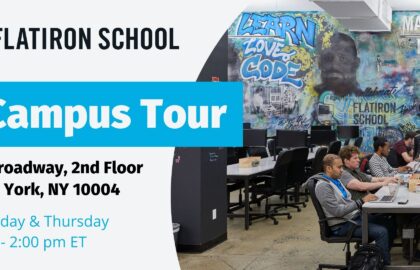This article on LinkedIn profiles is part of the Coaching Collective series, featuring tips and expertise from Flatiron School Career Coaches. Every Flatiron School graduate receives up to 180 days of 1:1 career coaching with one of our professional coaches. This series is a glimpse of the expertise you can access during career coaching at Flatiron School.
You’ve worked hard through training to earn your certificate, now it’s time to get a job! To get your job search started on the right foot, it’s key to revamp your LinkedIn profile.
LinkedIn is the top resource for job-seekers to find employment and navigate successful career transitions. Don’t believe me? Take a look at the facts on how the platform can supercharge your search:
- Over 50 million companies have a presence on Linkedin1
- More than 90% of recruiters search for candidates on LinkedIn to fill positions1
- LinkedIn is the best overall tool for recruiters to reach out to prospective candidates1
- LinkedIn remains the most-used channel for recruitment efforts1
Your LinkedIn profile is your online introduction to the world – a virtual business card, resume, and electronic handshake. It gives you the opportunity to showcase your projects, top skills, work experience, education, and – most importantly – your career aspirations all in one place.
Customizing the below 3 areas is the ticket to success when applying for positions and most importantly, networking or employment.
Your Business Card
While this isn’t a formally titled field, you should consider the top of your Linkedin profile (what visitors see before they scroll) to be your digital business card. It contains all the same things – your name, title/profession, and contact information. Here are 3 ways to make sure your above-the-digital-fold impression is a good one.
Profile Picture
A quality profile picture is very important. You don’t have to go to a professional photographer to get a LinkedIn-ready picture either. Grab your cell phone, a friend, and some good light and you’re good to go.
Top tips:
- Natural light is your friend. Find a well-lit spot to brighten your face. (But not so bright that you squint)
- Look straight at the camera and smile. You want your profile pic to be positive and welcoming.
- Dress business casual, like you would in an office setting.
- Take several shots so you have several to choose from.
Title & Tagline
These are the words listed under your name at the top of your profile.
Your title and tagline should describe who you are and what you do, instead of your current job title and company which LinkedIn pre-populates whenever you update your experience.
Start with your “title”, such as Software Engineer. Follow with your top skills.
Here is an example:
Yoshi Central, BS
Software Engineer | Full Stack | JavaScript | React.js | Ruby on Rails | HTML | CSS
Background Image
While many background images feature a city skyline or a nature scene, this is an opportunity to broadcast your professional aspirations. Select an image that relates to your current or desired position.
A software engineer might choose a computer screen filled with technical code. Product Designers might feature a stylish application interface. Whatever it is, keep it professional and in line with your personal brand.
About/Summary
This is where you can tell people more about you, your work history, your accomplishments, and your career goals. It is your opportunity to be a bit more casual and share your talents, passions, what you are proud of, and what you hope to accomplish.
You can also list your top skills in this section. Instead of recruiters and hiring managers scrolling to the skills section at the bottom of the page, this is a wonderful opportunity for you to put your best skills right in front of them.
Your skills should be listed for both your educational experience(s) and your professional background, even if they have nothing to do with the industry you’d like to be employed in.
Transferable skills from non-related history such as teamwork, meeting deadlines, collaboration, time management, and more can be exactly what recruiters are looking for.
Same About/Summary Section
Here is an example of a recent Flatiron School graduate’s About section:
Full Stack Developer with a diverse professional background in business management, hospitality, retail, and music performance. Experienced working with Ruby on Rails, JavaScript, and React. Thrive when creating programs and solutions centered on improving the customer experience through new technologies and past successes in business operations.
JavaScript
React
Ruby on Rails
SQL and ActiveRecord
10 years of professional experience working in the Point of Sale (POS) retail space that involved tech support, inventory management sales, inventory management, and scheduling. Recognized and promoted for customer service excellence, technical accomplishment, and sales.
Team Dynamics
Communication
Scheduling
Kronos
Business Administration
You can see where the job-seeker mentioned both their educational and professional experience and listed skills for both. A great way to highlight your training certificates and past professional achievements (or degrees/studies/etc.) is to write something along the lines of: “I look forward to combining my newly earned certification in [BLANK] and my past professional experience in [INDUSTRY] in my next position in [INDUSTRY].”
Your Experience
Use your resume to fill this section. You can “copy and paste” each of your experiences, including the listed bullet points under each.
If you don’t have much relevant experience, you can also add your Flatiron School education here in order to highlight it. This gives you the opportunity to include your projects higher up on your profile as well.
Here’s an example of how to include Flatiron School in the experience section:
Certificate – Software Engineering – Full Stack | Ruby on Rails | JavaScript | React
15-Week Intensive // Full Stack Software Engineering Program
– Front End: Javascript (ES6+), React.js
– Back End: Ruby, Ruby on Rails, SQL, ORMs & Active Record
Sample Technical Project Listing
—————-TECHNICAL PROJECTS—————
App Title | App Address
A digital card-trading application that allows a user to collect their own “set” of cards through a randomized process and trade those cards with other users through an open market process.- Modeled customer, card, trade, and library database schemas and REST APIs using Ruby on Rails, Postgresql, and ActiveRecord
– Developed front-end using React.js, Bootstrap, and CSS to create a streamlined user experience
– Implemented ActionMailer through Rails to send new users to welcome and trade confirmation emails
– Utilized “Figaro” gem to safely store email credentials in environment variables
– Implemented secure user authentication using bcrypt gem
Top tips:
- Be proactive with descriptions – list your impact on each organization.
- Brag a bit about the impact you made at past positions and list your awards or accomplishments within each experience.
- Include numerical representations whenever possible to emphasize your impact and meaningful results
- There is no “1-page limit” on LinkedIn, so include everything you can (that is relevant).
Now go for it! This is your chase to make an amazing first impression!
About Susan Brophy, MS Ed.
Susan Brophy is a career coach with Flatiron School. She has been a career counselor/coach, outplacement, and workforce development consultant for over 20 years. As the founder of Career Forward, Susan helps new graduates and those experiencing job loss, termination, or career transition find new and exciting careers.
Source:
- https://www.apollotechnical.com/




